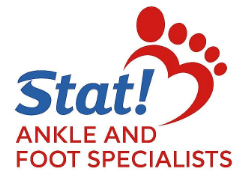Flatfoot (also known as fallen arches) is a condition where the arch of the foot flattens, causing the entire sole to make contact with the ground. This condition can cause pain, discomfort, and difficulty walking. At StatPodiatry, we offer expert care and treatments to help manage flatfoot and improve your foot health.
What Causes Flatfoot?
Flatfoot can develop due to a variety of factors, including:
- Genetics: Some people are born with flat feet, which can be inherited.
- Weak or Stretched Tendons: Over time, the tendons that support the arch can weaken or stretch, causing the arch to collapse.
- Aging: As you age, the tendons in your feet may weaken, leading to a gradual loss of the arch.
- Injury: Foot injuries, especially fractures or sprains, can damage the tendons and lead to flatfoot.
- Health Conditions: Conditions such as rheumatoid arthritis and diabetes can contribute to the development of flatfoot by affecting the tendons and ligaments in the foot.
- Obesity: Extra weight puts additional strain on the feet, increasing the likelihood of developing flatfoot.
Symptoms of Flatfoot
People with flatfoot may experience various symptoms, including:
- Pain in the feet or arches: Especially after prolonged standing or walking.
- Swelling: Around the ankles or the arch of the foot.
- Tired feet: A feeling of fatigue after walking or standing for extended periods.
- Postural issues: Flatfoot can cause changes in posture and lead to pain in the knees, hips, or lower back due to altered gait.
- Increased pronation: This is when the foot rolls inward excessively while walking, which can lead to more strain and pain.
Treatment Options for Flatfoot
Treatment for flatfoot depends on the severity of the condition. Options include:
- Conservative Treatments:
- Arch Supports and Orthotics: Custom-made insoles can provide support and help redistribute weight more evenly across the foot.
- Proper Footwear: Shoes with good arch support and cushioning can help alleviate pain and prevent further damage.
- Physical Therapy: Exercises to strengthen the foot muscles and improve flexibility can help alleviate pain and prevent worsening of the condition.
- Stretching: Regular stretching of the Achilles tendon and calf muscles can help relieve tension in the foot.
- Medications: Anti-inflammatory drugs (NSAIDs) can be prescribed to reduce pain and inflammation.
- Surgical Treatment: In severe cases, surgery may be required to correct the deformity, such as tendon repairs, realignment, or even ankle fusion surgery.
Why Choose StatPodiatry for Flatfoot Treatment?
At StatPodiatry, we specialize in diagnosing and treating flatfoot. Dr. Abad Majeed DPM offers personalized care and treatment plans tailored to your needs. We work to restore the natural function and comfort of your feet, so you can continue to live an active, pain-free life.
Convenient Locations
Visit StatPodiatry for expert flatfoot treatment:
- Schaumburg, IL – 847-301-1212
- Park Ridge, IL – 847-904-7400
- Arlington Heights, IL – 847-392-7400
Get Relief from Flatfoot Today
If you’re suffering from flatfoot, contact StatPodiatry today to schedule an appointment with Dr. Abad Majeed DPM. We’ll help you explore the best treatment options for your condition.
